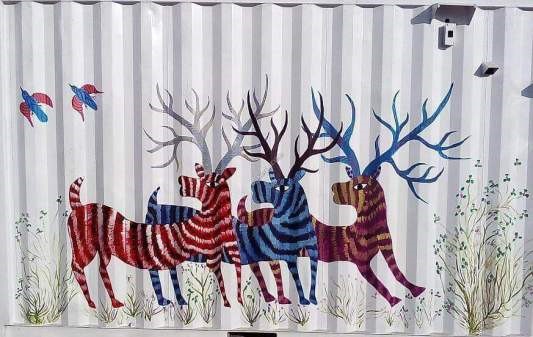Description

Disclaimer: Copyright infringement not intended.
Context
- The famed Gond painting of Madhya Pradesh has received the prestigious Geographical Indication (GI) tag.
What is a geographical Indication (GI) tag?
- A geographical Indication (GI) tag is a sign used on products which have a specific geographical origin and possess qualities or a reputation that are due to that origin.
- It is used for industrial products, foodstuff, agriculture products, spirit drinks, and handicrafts.
- GI Tag ensures that no one other than the registered authorised user is allowed to use the name of the popular product.
About the Gond Paintings
- Gond painting is a famous folk art of the Gond tribal community of central India.
- It is done to preserve and communicate the culture of the Gond tribal community.
- Gond tribal art includes folk dances, folk songs, and Gond paintings.
- It is mainly done in Patangarh Village in Dindori district of Madhya Pradesh.

Evolution
- The present-day Gond paintings have evolved from Digna and Bhittichitra.
- The Gonds paint Digna, a traditional geometric pattern on the walls and floors of the houses.
- Bhittichitra is painted on the walls of houses, and these paintings include images of animals, plants, and trees.
- Women use natural colors to paint the walls and floors of their homes.
- In the 1980s, J Swaminathan was the director of the Bharat Bhavan Museum in Bhopal. He wanted to exhibit urban and tribal art together. For this purpose, he sent some of his students to various villages in Dindori district in search of various tribal Gond artists.
- There they found very talented young men and women. One of them was Jangarh Singh Shyam, an exceptionally talented painter.
- Jangarh Singh Shyam was a Pardhan Gond artist of the village Patangarh in Dindori district in Madhya Pradesh.
- Pardhan Gonds are one of the subgroups of the Gond community. Pardhan Gonds are known for their artistic skills such as music, singing, painting, etc.
- Jangarh Singh Shyam became famous by exhibiting his paintings in Tokyo and Paris. The Gond painting thus gained worldwide recognition and became the livelihood of many tribal families.
What is explained through these paintings?
- They tell us about nature, trees, plants, animals, moon, sun, river, drains, God and Goddesses.
- What foods are fed, how plough is made, how the king used to fight, how the powers of tantra mantra (Black magic) worked, all this is explained through the painting
Gond Painting Raw Materials
- Paper/Canvas: Handmade paper, canvas or even chart paper that are readily available in the market are used to make Gond paintings.
- Colors: Bright colors such as red, yellow, blue, green, etc., are commonly used in Gond art. Natural colors are obtained from charcoal, colored soils, plants, leaves, cow dung, etc. Gond artists are now using synthetic colors such as acrylic colors, poster colors and oil paints as they are readily available in the market.
- Tools: Paintbrushes of various sizes are now used to make Gond paintings.
Gond Painting Themes & Designs
- The themes and motifs of Gond painting are drawn from local flora and fauna, deities and urban culture. Gond paintings mainly depict the following subjects: –
- Pictures of peacocks, birds, crabs, mythical beasts, lizards, lions, tigers, deer, snakes, wild boars, cows, monkeys, elephants, horses, fish, etc.
- Mahua Tree as Tree of Life. Mahua flowers, fruits, seeds, and leaves are used for many purposes by the Gond tribe.
- Modern design such as airplanes, bicycles, cars, technology, etc.
- Myths, legends, and aspects of the daily life of Gond people.
- Hindu gods such as Lord Shiva, Lord Krishna, Lord Ganesha, etc.
- Local deities like Phulvari Devi (Goddess Kali), Jalharin Devi (River Goddess), Marahi Devi, etc
- Folktales
Signature Patterns
- Each Gond artist uses his own distinctive pattern and style to fill the images. These distinctive patterns are called signature patterns. Some of the patterns used in Gond paintings are: Dots, Fine Lines, Curved Lines, Dashes, Fish Scales, Drops of Water, Seed Shapes and Geometrical Shapes, etc.

About Gond Tribe
- The Gond tribe is one of the largest tribal communities in India.
Meaning of the word Gond
- The word Gond comes from ‘Kond’ which means green mountains and tribal people are called Gondis as they live mainly in the lush green mountains of Madhya Pradesh.
Location
- These tribals live in Madhya Pradesh, Telangana, Bihar, Maharashtra, Odisha, and Andhra Pradesh.
Occupation
- The main occupation of the Gond tribe is agriculture or daily wages.
Significance of Gond paintings
- The Gond tribe believes that seeing a good image brings lots of good luck to them. Hence Gond tribal paintings are made on various festivals, rituals, and ceremonies such as Diwali, Karva Chauth, Nag Panchami, birth, marriage, etc.
|
PRACTICE QUESTION
Q) Which of the following statements with reference to Gond Paintings is/are incorrect?
a. Gond painting is a famous folk art of Maharshtra.
b. The Gond painters use natural colors only.
- a only
- b only
- both a and b
- neither a nor b
Correct Answer: 3
|

https://theprint.in/india/madhya-pradeshs-gond-painting-gets-gi-tag/1511637/















